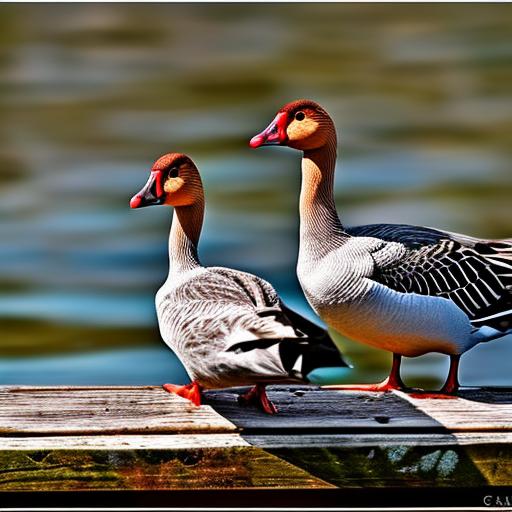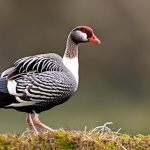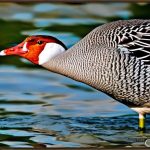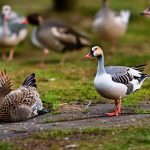The presence of geese in urban areas has become a growing problem in recent years. These birds are attracted to areas with open water, lush grass, and ample food sources, which are often found in parks, golf courses, and residential areas. While geese can be a beautiful sight to behold, their presence can also lead to a number of issues such as property damage, health risks, and aggressive behavior. In order to address this problem, various strategies can be employed to deter geese from these areas.
Key Takeaways
- Geese are social animals and tend to congregate in areas with water and food sources.
- Physical barriers such as fences and netting can be effective in keeping geese away from certain areas.
- Sound and light devices can be used to deter geese, but they may become less effective over time.
- Scarecrows can be effective in deterring geese, but they need to be moved regularly to maintain their effectiveness.
- Natural deterrents such as planting certain types of vegetation or using decoys can be effective in deterring geese.
Understanding the Behavior of Geese
Geese are attracted to certain areas for a variety of reasons. One of the main factors is the availability of food sources. Geese are herbivores and feed on grasses, grains, and aquatic plants. Areas with lush grass and open water provide an abundant food supply for these birds. Additionally, geese are social animals and are often attracted to areas where other geese are present. They form large flocks and are known to return to the same nesting sites year after year.
To deter geese from these areas, it is important to understand their behavior and implement strategies that target their specific behaviors. For example, geese are known to be territorial and will defend their nesting sites aggressively. By creating physical barriers or alternative nesting sites, it is possible to discourage geese from nesting in unwanted areas. Additionally, geese have a strong sense of hearing and can be easily startled by loud noises or bright lights. Using sound and light devices can be an effective way to repel geese from specific areas.
Installing Physical Barriers to Deter Geese
One strategy for deterring geese is to install physical barriers that prevent them from accessing certain areas. There are several types of physical barriers that can be used, including fences, netting, and floating barriers. Fences can be effective in keeping geese out of specific areas, but they need to be at least three feet high to prevent the birds from flying over them. Netting can be used to cover areas such as ponds or gardens, preventing geese from accessing these spaces. Floating barriers can be placed in bodies of water to create a physical barrier that prevents geese from swimming or landing in the area.
While physical barriers can be effective in deterring geese, there are also some drawbacks to consider. For example, fences and netting can be expensive to install and may not be aesthetically pleasing. Additionally, floating barriers may not be effective if the water is shallow or if the geese are determined to access the area. It is important to carefully consider the specific needs of the area and the behavior of the geese before implementing physical barriers.
Using Sound and Light to Repel Geese
Another strategy for deterring geese is to use sound and light devices that repel them from specific areas. There are several types of devices that can be used, including sonic devices, strobe lights, and laser pointers. Sonic devices emit loud noises that startle geese and make them uncomfortable. Strobe lights emit bright flashes of light that disorient geese and make it difficult for them to navigate. Laser pointers can be used to create a moving light source that scares geese away.
These sound and light devices work by exploiting the natural instincts of geese. Geese have a strong sense of hearing and are easily startled by loud noises. They also have sensitive eyesight and are sensitive to bright lights. By using these devices, it is possible to create an environment that is uncomfortable for geese and discourages them from staying in the area.
Implementing a Scarecrow Strategy
Scarecrows have long been used as a deterrent for birds, including geese. The presence of a scarecrow can create a visual deterrent that makes geese uncomfortable and encourages them to find another area to feed or nest. Scarecrows can be made from a variety of materials, including old clothes, straw, and sticks. It is important to create a scarecrow that is realistic and resembles a human figure, as geese are more likely to be scared off by something that looks like a potential predator.
To create an effective scarecrow, it is important to place it in an area where geese are likely to congregate. This could be near a pond or lake, or in an open field where geese are known to feed. It is also important to move the scarecrow periodically, as geese can become accustomed to its presence if it remains in the same location for an extended period of time.
Employing Natural Deterrents

There are several natural deterrents that can be used to discourage geese from certain areas. One of the most effective natural deterrents is the presence of predators. Geese are naturally wary of predators such as dogs, coyotes, and foxes. By introducing these predators into the area, either through the use of trained dogs or by creating a habitat that attracts natural predators, it is possible to deter geese from nesting or feeding in the area.
Another natural deterrent is the use of plants that geese find unappealing. Geese prefer areas with short grass and open spaces where they can easily spot potential threats. By planting tall grasses or shrubs in areas where geese are likely to congregate, it is possible to create an environment that is less attractive to these birds.
Using Chemical Repellents Safely and Effectively
Chemical repellents can be used as a last resort for deterring geese from certain areas. There are several types of chemical repellents that can be used, including taste repellents and visual repellents. Taste repellents are applied to grass or other vegetation and make it unappealing for geese to feed on. Visual repellents are applied to surfaces such as docks or buildings and create a visual deterrent that makes geese uncomfortable.
When using chemical repellents, it is important to follow the instructions carefully and use them in a safe and responsible manner. Some chemical repellents can be harmful to humans, pets, or other wildlife, so it is important to choose products that are safe and environmentally friendly. It is also important to reapply the repellents regularly, as they can wear off over time.
Keeping the Dock Area Clean and Tidy
One of the most effective ways to deter geese from nesting in an area is to keep it clean and tidy. Geese are attracted to areas with open water and lush grass, but they are also attracted to areas with ample food sources. By keeping the dock area clean and free of food scraps or other debris, it is possible to discourage geese from nesting in the area.
It is also important to regularly remove any goose droppings from the dock area. Geese are attracted to areas where they have previously nested, so by removing their droppings, it is possible to discourage them from returning. Additionally, by keeping the dock area clean and tidy, it is possible to reduce the risk of health issues associated with goose droppings.
Creating Alternative Nesting Sites for Geese
One strategy for managing geese populations is to create alternative nesting sites for them. Geese are known to return to the same nesting sites year after year, so by providing them with alternative options, it is possible to discourage them from nesting in unwanted areas. This can be done by installing nesting platforms or boxes in areas where geese are likely to congregate.
When creating alternative nesting sites, it is important to consider the specific needs of geese. They prefer areas that are near water and have ample food sources. Additionally, the nesting sites should be elevated and protected from predators. By providing geese with suitable alternative nesting sites, it is possible to reduce the likelihood of them nesting in unwanted areas.
Seeking Professional Help for Persistent Geese Problems
If all else fails, it may be necessary to seek professional help for persistent geese problems. There are companies that specialize in geese management and can provide expert advice and assistance. These professionals have experience in dealing with geese and can offer effective solutions for deterring them from specific areas.
When seeking professional help, it is important to choose a reputable company that has a proven track record of success. It is also important to communicate clearly about the specific issues you are experiencing and the desired outcome. By working with a professional geese management company, it is possible to find a solution that is tailored to your specific needs.
Developing a Long-Term Geese Management Plan
In order to effectively manage geese populations, it is important to develop a long-term management plan. This plan should include a combination of strategies that target the specific behaviors of geese and address the underlying issues that attract them to certain areas. It should also include regular monitoring and evaluation to ensure that the strategies are effective and make any necessary adjustments.
When developing a long-term geese management plan, it is important to involve all stakeholders, including property owners, residents, and local authorities. By working together, it is possible to create a comprehensive plan that addresses the concerns of all parties involved. It is also important to communicate regularly with stakeholders and provide updates on the progress of the management plan.
In conclusion, managing geese populations in urban areas can be a challenging task. However, by understanding their behavior and implementing effective strategies, it is possible to deter geese from unwanted areas. Physical barriers, sound and light devices, scarecrows, natural deterrents, chemical repellents, and maintaining a clean and tidy environment are all strategies that can be used to manage geese populations. Additionally, creating alternative nesting sites, seeking professional help, and developing a long-term management plan are important steps in effectively managing geese populations. By taking action and implementing these strategies, it is possible to create a safe and enjoyable environment for both humans and geese.
If you’re looking for effective ways to keep geese away from your dock, you might also be interested in learning how to build a chicken coop that is portable and easy to move around. Poultry Wizard offers a helpful article on “Chicken Coop Portage” that provides step-by-step instructions and tips on creating a coop that can be easily relocated. By implementing some of these techniques, you can not only protect your dock from geese but also have the flexibility to move your chicken coop wherever it’s needed. Check out the article here for more information.
FAQs
What are some effective ways to keep geese away from a dock?
There are several effective ways to keep geese away from a dock, including using decoys, installing bird netting, using motion-activated sprinklers, and applying goose repellent.
What are some natural ways to keep geese away from a dock?
Some natural ways to keep geese away from a dock include planting tall grasses or shrubs around the area, using reflective tape or balloons, and introducing natural predators like dogs or hawks.
Why are geese attracted to docks?
Geese are attracted to docks because they provide a safe and elevated area for them to rest and nest. Docks also often have easy access to water and nearby grassy areas for feeding.
Are there any legal restrictions on how to keep geese away from a dock?
Yes, there may be legal restrictions on how to keep geese away from a dock, depending on the location and the methods used. It is important to check with local authorities and follow any regulations or guidelines.
What are some potential risks associated with geese on a dock?
Geese on a dock can pose several risks, including damage to the dock and surrounding property, health hazards from their droppings, and potential aggression towards humans or pets.
Meet Walter, the feathered-friend fanatic of Florida! Nestled in the sunshine state, Walter struts through life with his feathered companions, clucking his way to happiness. With a coop that’s fancier than a five-star hotel, he’s the Don Juan of the chicken world. When he’s not teaching his hens to do the cha-cha, you’ll find him in a heated debate with his prized rooster, Sir Clucks-a-Lot. Walter’s poultry passion is no yolk; he’s the sunny-side-up guy you never knew you needed in your flock of friends!







